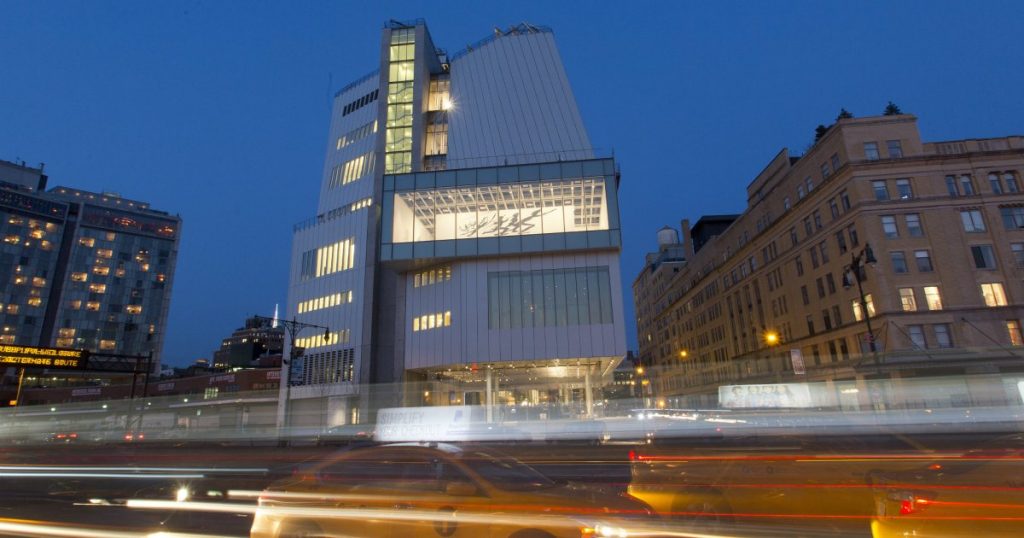The Fascinating Ways Museums Prepare for Catastrophic Weather
That’s due primarily to the fact that the $650 million buildings, which were started before Sandy hit, reportedly go beyond even the city’s newest resilient design codes—and look great doing it. Connected by a three-story skybridge, the two towers have an elevated lobby that makes them virtually waterproof. The building is also served by rooftop backup generators that promise enough energy to run the elevators plus one fridge and one electrical outlet in each apartment indefinitely. In January, the New York Times wrote this glowing report:
There is a breathtaking view of the mid-Manhattan skyline, pierced by the Empire State Building, from the 48th floor of the taller of two new copper-clad apartment towers along the East River, just south of the United Nations.
No plutocrat will enjoy it, however. This impressive penthouse aerie is hogged by five emergency generators. The window is already blocked by a bank of electrical switchgear. For the developers, giving up premium space to machinery is insurance against an ominous future: They want tenants in the towers’ 760 apartments to be able to live in their apartments for at least a week, no matter how high floodwaters may reach nor how long the power is out.
Sure, in the face of an impending storm, residents will still have to get the hell out just like any other New Yorker adhering to evacuation mandates. But American Copper promises them a return to a clean, safe, and electrified home.
Though JDS Development Group, which owns American Copper Buildings, may have been leading the charge on resilient design, the rest of New York City’s new construction is quickly catching up. After Sandy, the Mayor’s Office of Recovery and Resiliency set about studying the metro area’s weather and climate vulnerabilities and crafting solutions. Recently, the city began implementing new building codes, and all new construction is now held to these updated resiliency standards. “We’re not just doing one-off resilience projects. We’re baking resilience into the entire capital program,” the city’s chief resilience officer Daniel Zarrilli says.
Even with the support of the city, resilient design can be hard to scale. Retrofitting old buildings is harder than raising more capital to bolster new designs, according to many architects. Raising an existing single-family home on stilts, as many thousands of East Coasters have done since Sandy, can cost more than $100,000—on a house that’s maybe only worth $400,000. That means that while the Whitney’s resilience costs were less than one-twentieth of the new project cost, the owner of an existing home is looking at resilience costs as high as one-fourth of their total property value. While some local and federal support has been made available to storm victims, the costs of these programs have quickly ballooned—even after many withdrew their applications due to overwhelming bureaucracy and out-of-date flood maps.
It’s clear that equitable resilience will take not just effort and money, but time. “There will just be a slow changeover of the entire housing stock in New York City that slowly meets these codes,” Simon Koster of JDS Development Group says. Given that 66 percent of New York City’s buildings were built before 1960 and aren’t likely to change over in the near future, this doesn’t seem particularly hopeful.
But other less intensive measures are being taken to ensure New Yorkers weather the next storm—and museums can serve as a model here, too. The Rubin, which showcases art from the Himalayan region, didn’t have the budget to undertake big post-Sandy capital improvement projects. While the board paid for a few big-ticket items like a stronger, waterproof roof, it’s poured most of its efforts into better training and communication. “We’re thinking about manual ways, simple ways, things you can buy on Amazon,” Sears says. One of his favorite investments is a windup cellphone charger that doesn’t require an electricity source.
Unlike 18-inch concrete walls, disaster plans like these can be constructed by anyone. But a 2015 Federal Emergency Management Agency survey showed only 39 percent of Americans have their own plan in place. The Rubin, which has a disaster plan 153 pages long, believes this has to change. Other museum strategists agree: “You can call it paranoia, or you can call it strategy,” says Kathy Greif of the Dalí Museum. “I prefer to call it strategy.”
If museums are so prepared, could they help the rest of us—literally? Not really. Unsurprisingly, you won’t be weathering the next hurricane from inside the Met. Though all of the museum leaders I spoke with agree that human lives matter more than paintings, serving as a shelter still seemed to compromise their central mission, which is protecting their collections. Even if it could theoretically provide reprieve, the Whitney sits on the leading edge of Evacuation Zone 1, which means people should be headed out of the neighborhood, not into even the most disaster-proof buildings. The Rubin, meanwhile, wouldn’t physically have the space to serve as a shelter during a flood, as art typically hung in lower-level galleries would be moved into many of the hallways and upper galleries. In the end, its strategies like these that will save the precious artwork. But it’s clear they’ll limit room for, well, people.





